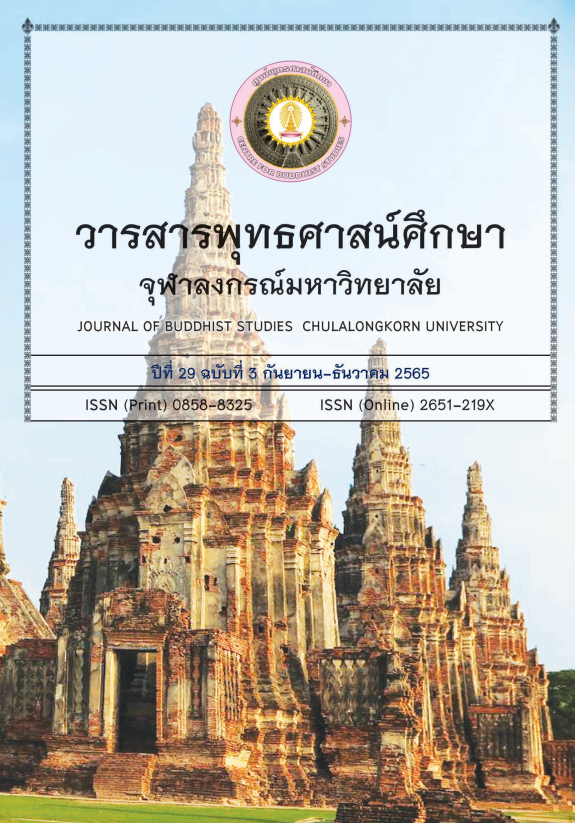Appearance and Method of Crowned and Bejeweled Buddha Images Before the 19th Century
Keywords:
Buddha Image, Crowned and Bejeweled Buddha Image, Before the 19th CenturyAbstract
The Buddha image is not only a representation of the Lord Buddha, but also a tool for studying artistic eras of different empires. This research article seeks to investigate the relationship and influence among, as well as the physical evolution and religious ideas of, crowned and bejeweled Buddha images before the 19th century in India, Burma, Cambodia, and Thailand.
The research found that 1) Indian art in the Pala style is regarded as the model for Crowned and Bejeweled Buddha Images, and has had significant impact on Bagan art (Burma) and Bayon art (Cambodia). Together, these three styles have influenced the arts of Hariphunchai, Srivichai, Lanna, and Lopburi in Thailand. Common beliefs, commerce, religious propagation, and even war helped to spread the popularity of the Crowned and Bejeweled Buddha Images in many areas. The differences in the appearance of the Buddha images depend on varying interpretations, on different combinations between the received art style and the original one, and on the adaptation of the received style to suit the artistic context of that society. 2) The Crowned and Bejeweled Buddha Images in Pala style (India) reflect the beliefs in the Buddha as the supreme being above all, in th e Trikāya, in the Buddha as the King of kings and as the Ādi-Buddha. Those in Bagan art style (Burma) reflect the beliefs in the Buddha as the King of kings, in the Jambupati-sutra, and in the Maitreya Buddha. The ones in Khmer art style (Cambodia) reflect the beliefs in the Buddha as the supreme being above all, in the Trikāya, in the Buddha as the King of kings and as the Adi-Buddha, in the Ratanatriya, and in Phra Bhaisajyaguru Vaitoonprapha (Medicine Buddha).
Downloads
References
กระทรวงวัฒนธรรม.(2550). ข้อควรระวังในการใช้สัญลักษณ์ทางพระพุทธศาสนา. กรุงเทพมหานคร: สํานักงานปลัดกระทรวงวัฒนธรรม.
จตุพร วรวัชรพงศ์. (2549). ที่มาของพระพุทธรูปทรงเครื่องศิลปะขอมที่พบ ในประเทศไทย. (วิทยานิพนธ์ปริญญามหาบัณฑิต, มหาวิทยาลัยศิลปากร).
เชษฐ์ ติงสัญชลี. (2558). ศิลปะไทยภายใต้แรงบันดาลใจจากศิลปะอินเดียแบบปาละ. กรุงเทพมหานคร: มติชน ปากเกร็ด.
นงเยาว์ ชาญณรงค์.(2553).วัฒนธรรมและศาสนา (พิมพ์ครั้งที่ 7 กรุงเทพมหานคร: มหาวิทยาลัยรามคําแหง.
นวลลออ ทินานนท์. (2543). ศิลปะพื้นบ้านไทย. กรุงเทพมหานคร: มหาวิทยาลัยศรีนครินทรวิโรฒ.
พระธรรมเมธาภรณ์ (ระแบบ ฐิตญาโณ). (2565). พระหริภุญชัยบรมโพธิสัตว์. สืบค้นจาก https://www.facebook.com/Rabaeb.Thitanyano/
มูลนิธิโครงการสารานุกรมไทยสําหรับเยาวชนฯ.(2549). พระพุทธรูปในศิลปะไทย สมัยต่าง ๆ. สืบค้นจาก http://saranukromthai.or.th/
ราม วัชรประดิษฐ์. (2559). พระพุทธรูปทรงเครื่อง: เครื่องทรงเยี่ยงกษัตริยาธิราช. สืบค้นจาก https://siamrath.co.th/n/7117.
รุ่งโรจน์ ธรรมรุ่งเรือง. (2558). รู้เรื่องพระพุทธรูป ที่มา คติความหมายศิลปกรรม ทุกยุคทุกสมัย (พิมพ์ครั้งที่ 2), กรุงเทพมหานคร: มิวเซียมเพรส.
ศักดิ์ชัย สายสิงห์. (2556). พระพุทธรูปสําคัญและพุทธศิลป์ในดินแดนไทย. กรุงเทพมหานคร: เมืองโบราณ.
ศักดิ์ชัย สายสิงห์. (2563). ศิลปะเขมรในประเทศไทย. เอกสารประกอบการสอนวิชา ประวัติศาสตร์ศิลปะไทย, กรุงเทพมหานคร.
ศิลป์ชัย ขิ้นประเสริฐ. (2529) พระพุทธรูปทรงมงกุฎเทริดในประเทศไทย. วารสารมหาวิทยาลัยศิลปากร, (7)1, 93-103.
ส.พลายน้อย. (2545). พระพุทธรูปสําคัญในประเทศไทย. กรุงเทพมหานคร: สารคดี.
สรศักดิ์ จันทร์วัฒนกุล. (2551). ประวัติศาสตร์และศิลปะแห่งอาณาจักรขอมโบราณ. กรุงเทพมหานคร: เมืองโบราณ.
สิรีรัศมิ์ สิงห์สนธิ. (2563). พระพุทธรูป : การตีความเชิงสัญลักษณ์ทางพระพุทธ ศาสนา. วารสาร มจร พุทธศาสตร์ปริทรรศน์, (4)1, 89-98.
สุภัทรดิศ ดิศกุล. (2515). ประติมากรรมขอม. กรุงเทพมหานคร : กรุงสยามการพิมพ์.
ห้องสมุด ศ.ม.จ.สุภัทรดิศ ดิศกุล. (ม.ป.ป.). ฐานข้อมูลภาพ. สืบค้นจาก http://www.thapra.lib.su.ac.th/
Art work of Siam. (2560). พระพุทธรูปทรงเครื่องศิลปะล้านนา. สืบค้นจาก https://www.facebook.com/Art-work-of-Siam-1657342637880170/
Downloads
Published
How to Cite
Issue
Section
License
Copyright (c) 2022 Chulalongkorn University Centre for Buddhist Studies

This work is licensed under a Creative Commons Attribution-NonCommercial-NoDerivatives 4.0 International License.
บทความที่ได้รับการตีพิมพ์เป็นลิขสิทธิ์ของศูนย์พุทธศาสน์ จุฬาลงกรณ์มหาวิทยาลัย
ข้อความที่ปรากฏในบทความแต่ละเรื่องในวารสารวิชาการเล่มนี้เป็นความคิดเห็นส่วนตัวของผู้เขียนแต่ละท่านไม่เกี่ยวข้องกับศูนย์พุทธศาสน์ จุฬาลงกรณ์มหาวิทยาลัย และคณาจารย์ท่านอื่นๆในมหาวิทยาลัยฯ แต่อย่างใด ความรับผิดชอบองค์ประกอบทั้งหมดของบทความแต่ละเรื่องเป็นของผู้เขียนแต่ละท่าน หากมีความผิดพลาดใดๆ ผู้เขียนแต่ละท่านจะรับผิดชอบบทความของตนเองแต่ผู้เดียว






